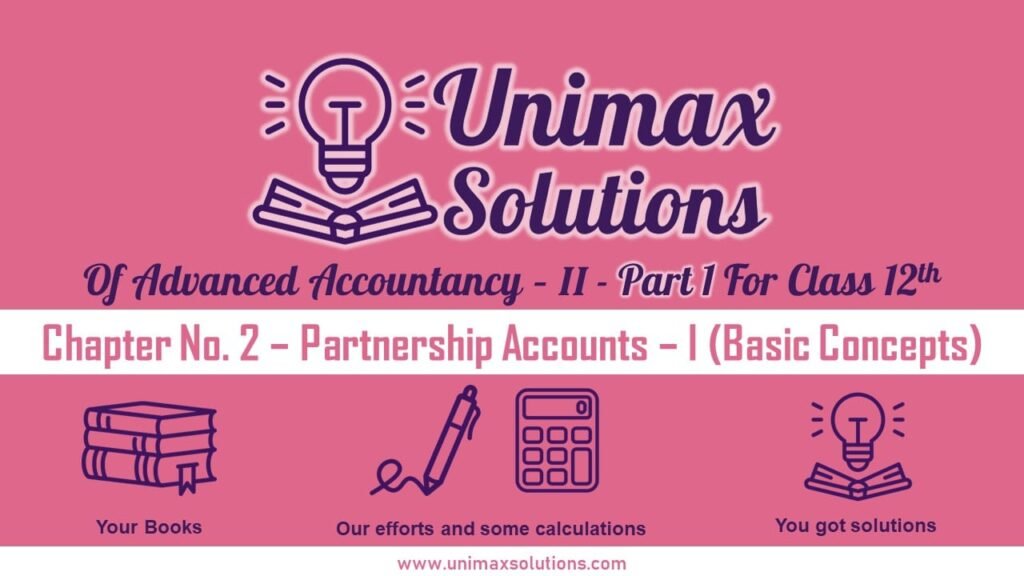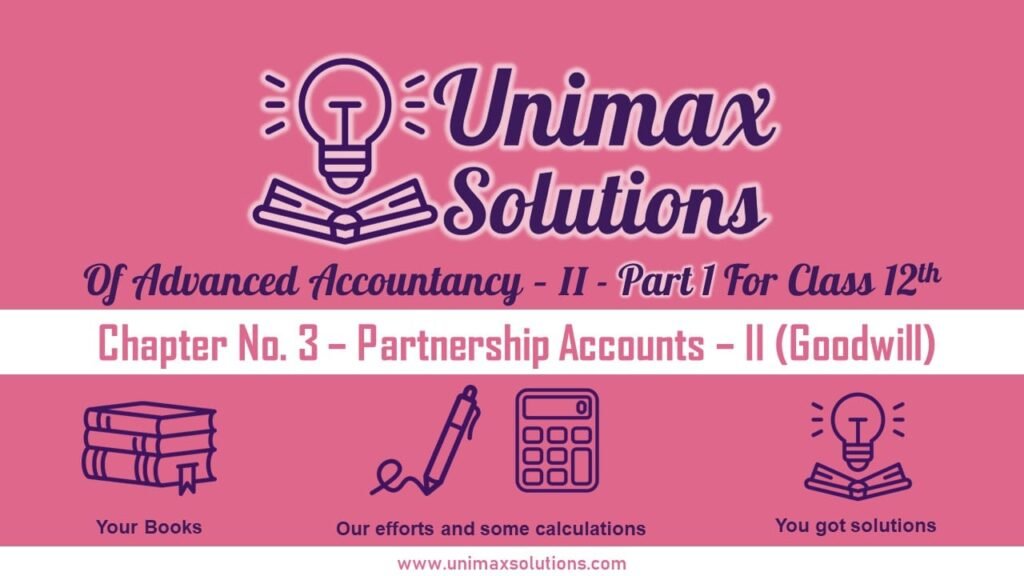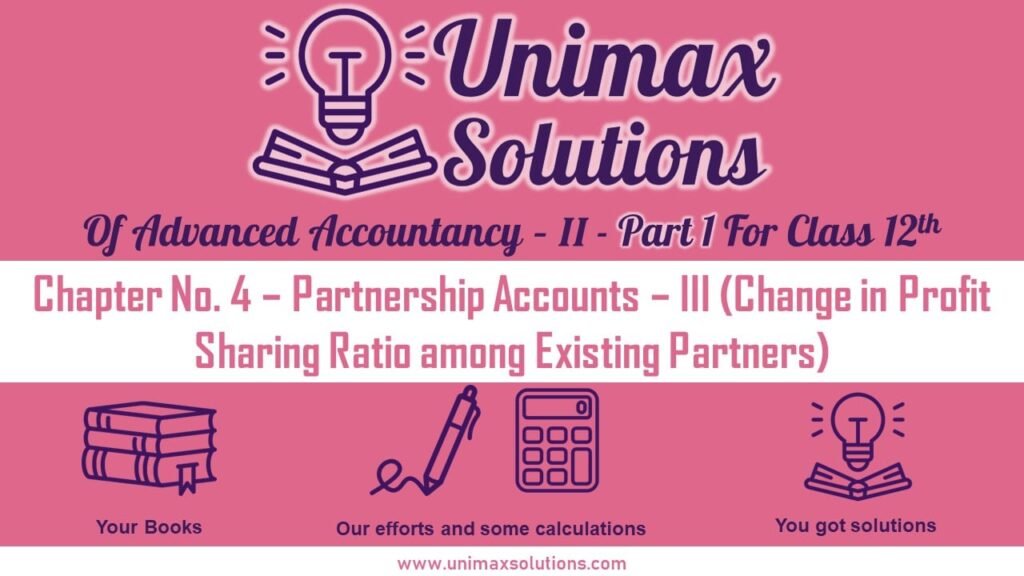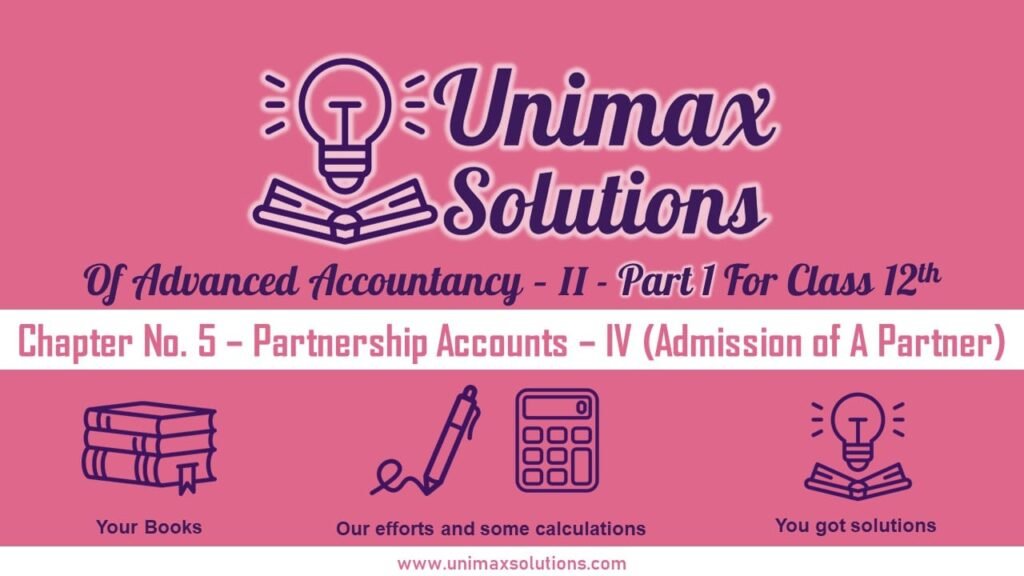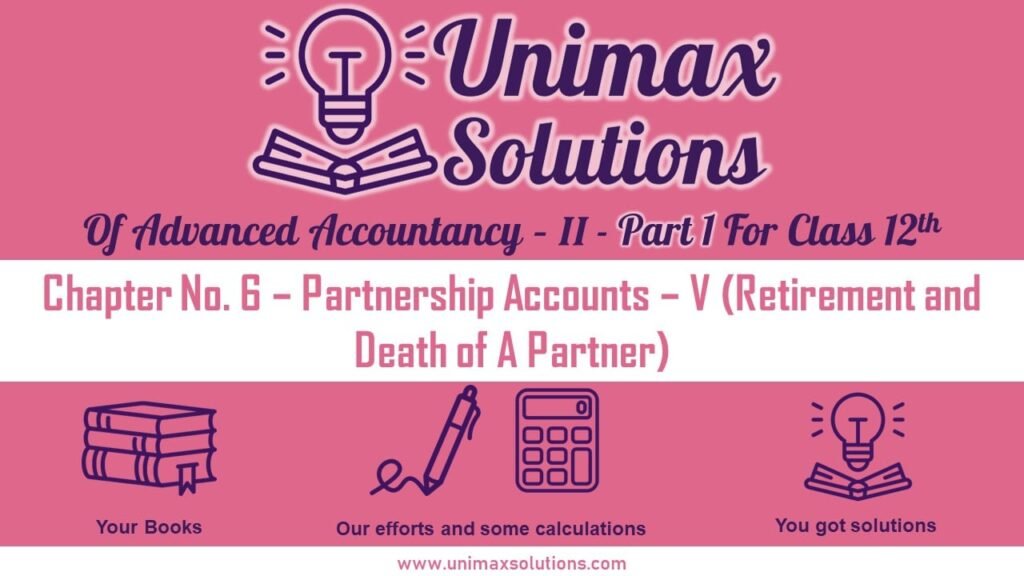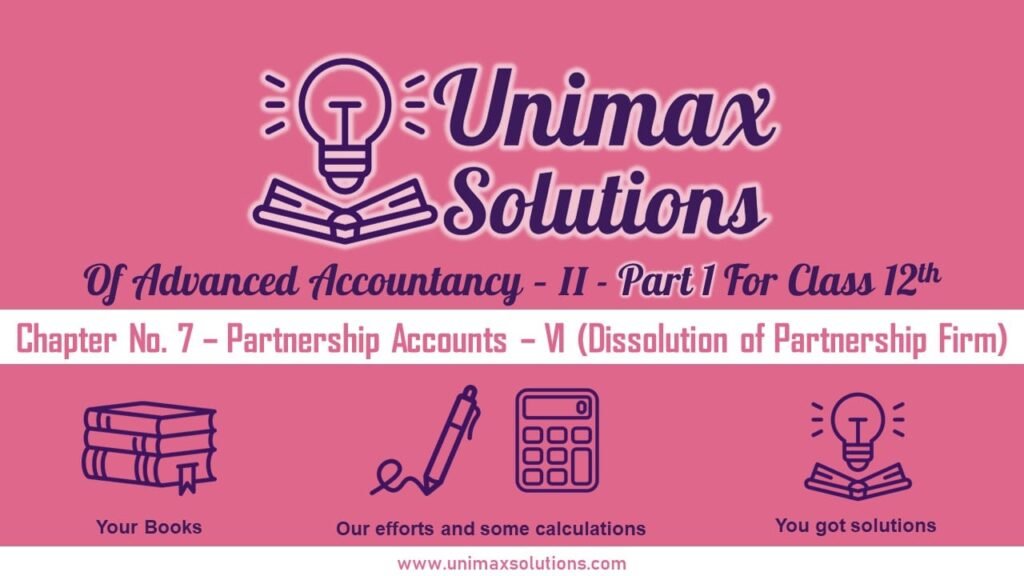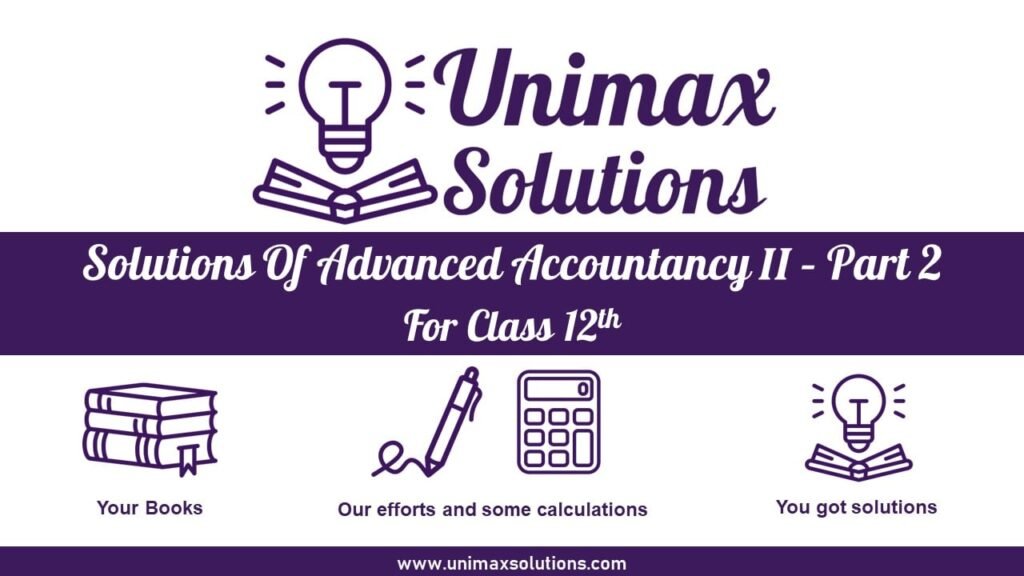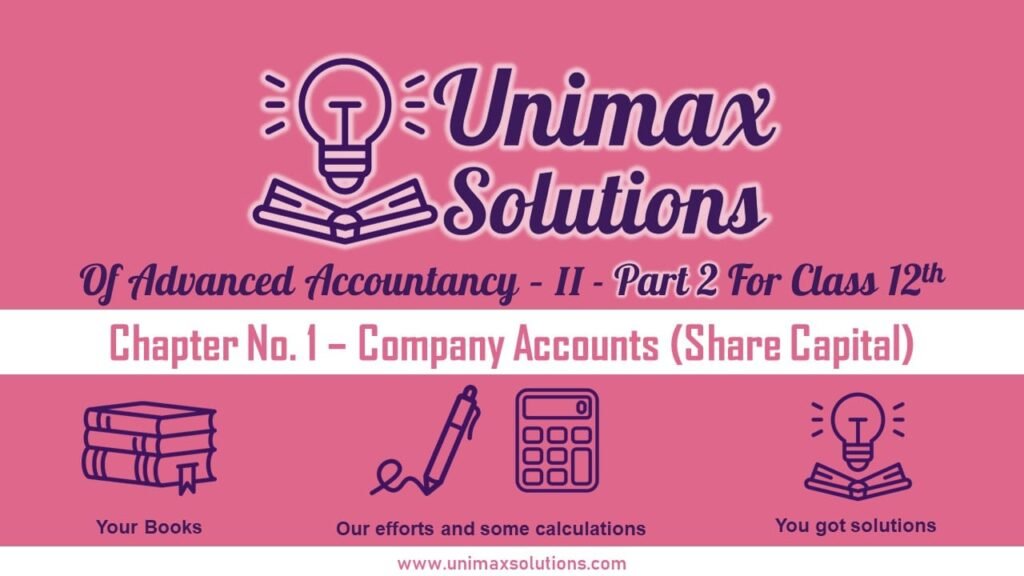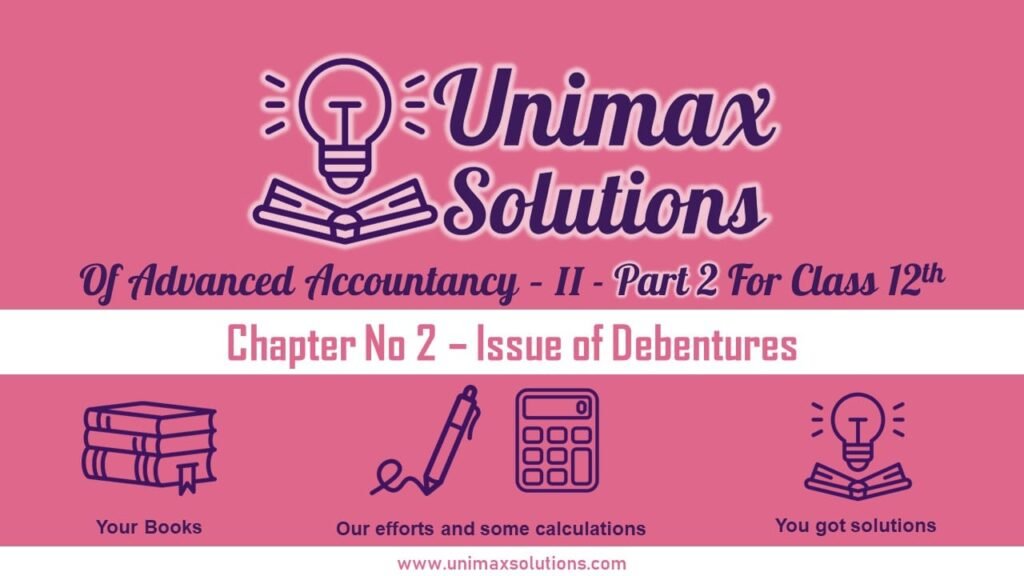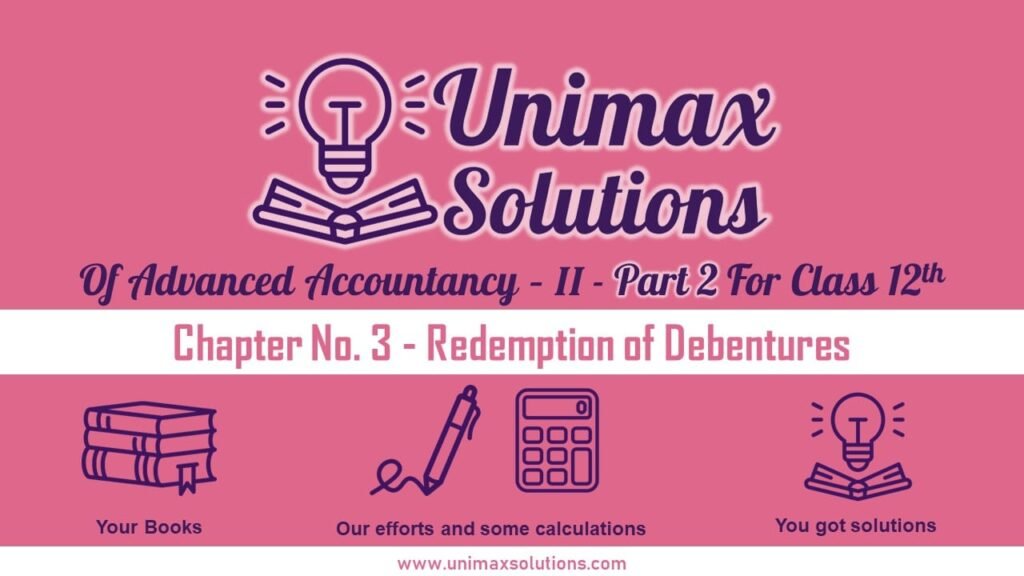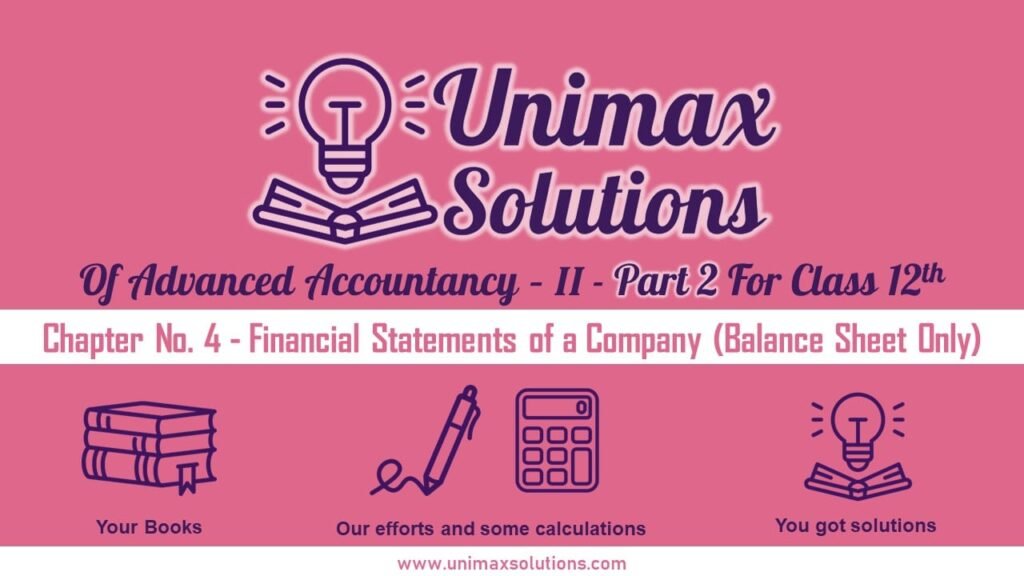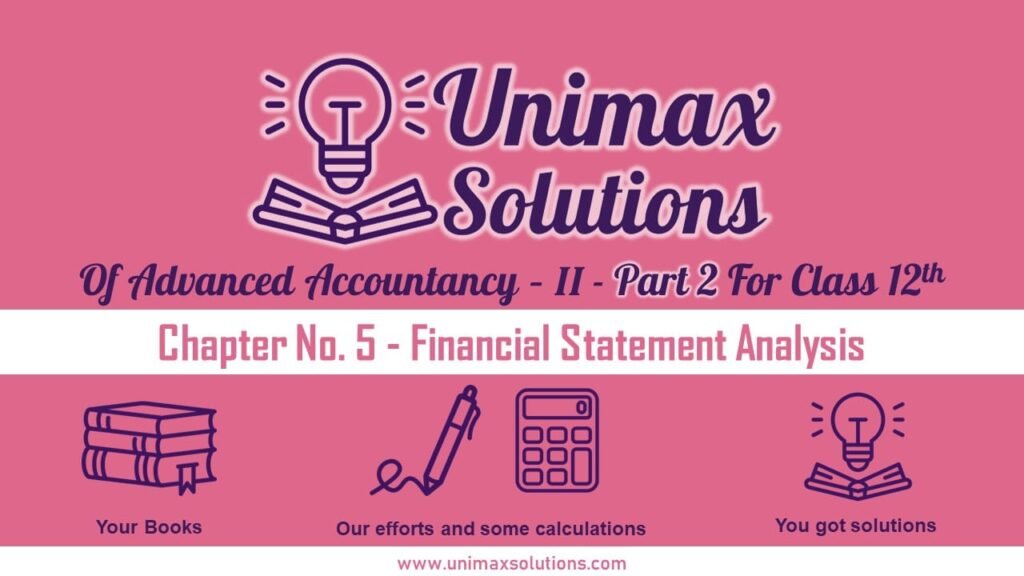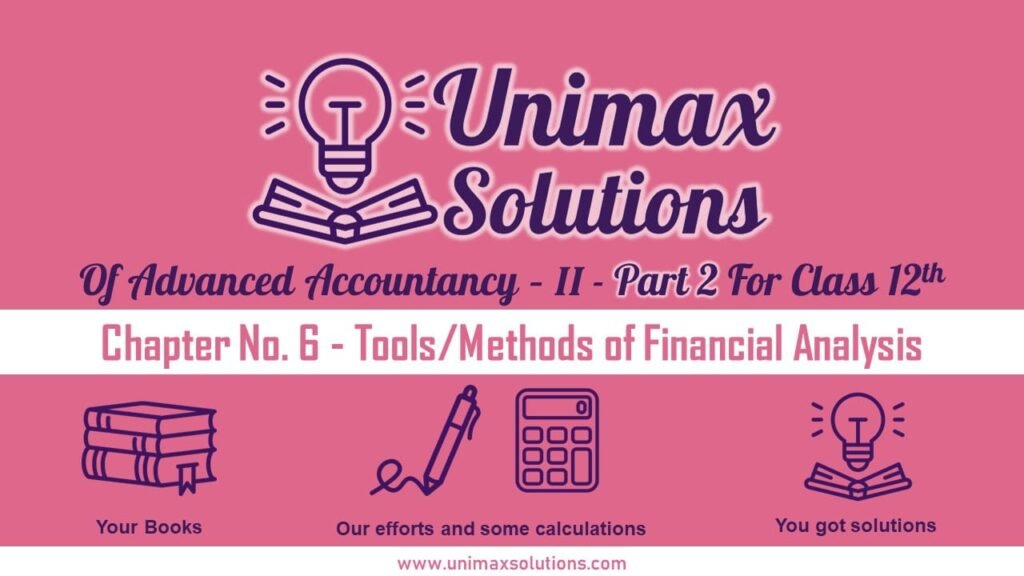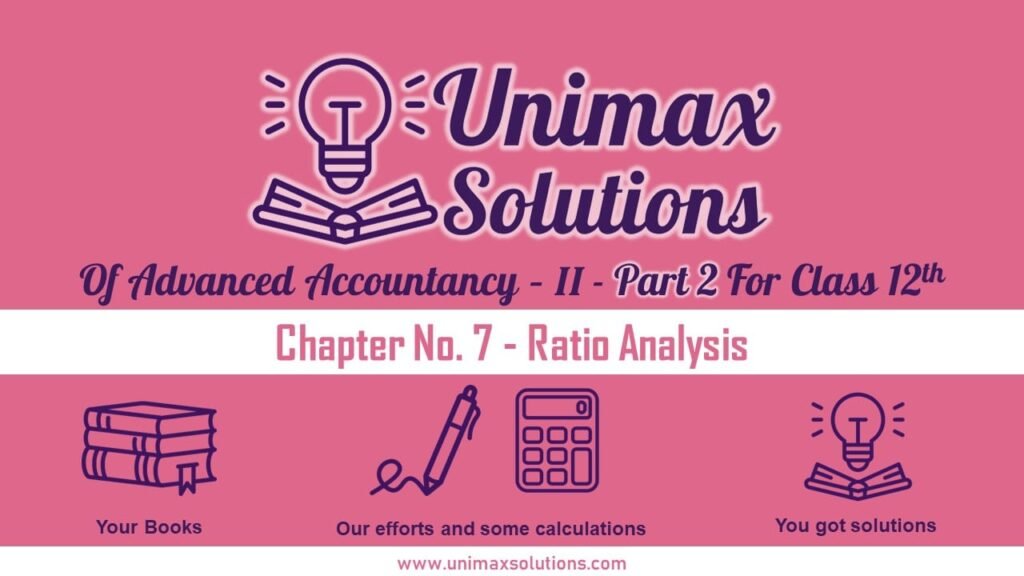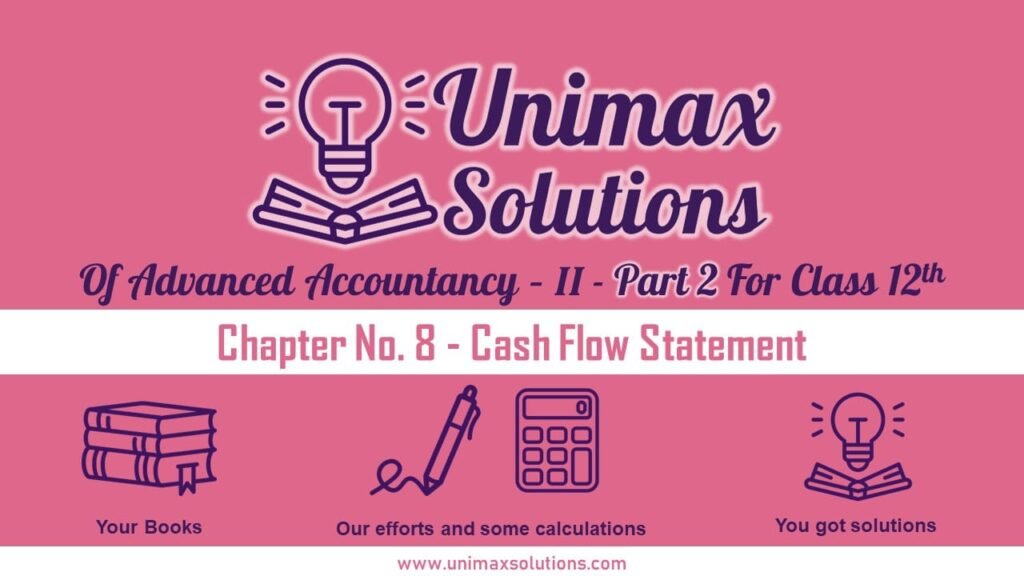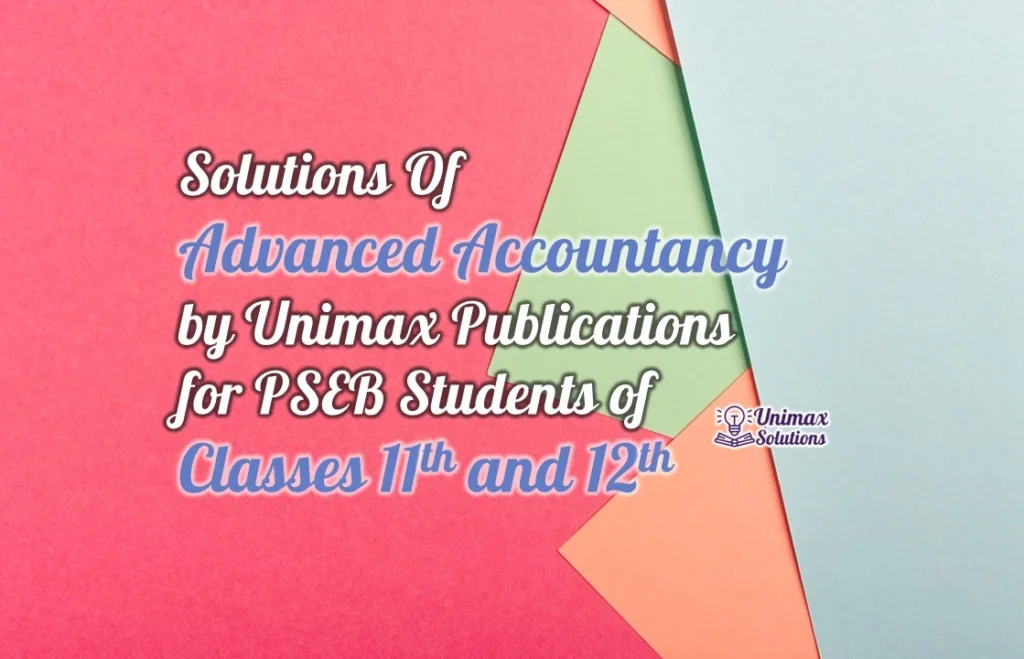
Advertisement
In the article of Solution of Advanced Accountancy by Unimax Publications for PSEB Students of Classes 11 and 12, We have solved the following three books of Advanced Accountancy by Unimax Publications for Classes 11 and 12. These books are covered by the syllabus provided by the Punjab School Education Board(PSEB):
- Advanced Accountancy I Class 11 – Solution
- Advanced Accountancy II Part 1 Class 12 – Solution
- Advanced Accountancy II Part 2 Class 12 – Solution
Solutions of Advanced Accountancy I Class 11 by Unimax
We have provided the question-wise of chapter-wise solutions to all practical problems of Unimax Publications – Advanced Accountancy-I- Class 11 – Solution. These are shown as follows: –
Part-I
Chapter No. 1 – Introduction of Accounting
Let’s talk numbers, but not just any numbers – the kind that makes businesses tick, thrive, or sometimes, sink. Welcome to the world of accounting, the art, and science of keeping track of financial transactions. It’s the language of business, a way to communicate a company’s financial health. Whether you’re a startup owner wearing multiple hats or a seasoned CFO, accounting is the backbone of your financial decision-making. So, grab a cup of coffee, and let’s demystify the numbers game, shall we?
Chapter No. 2 – Theory Base of Accounting
Ever wondered what the bedrock on which the mighty edifice of accounting stands? It’s not just about crunching numbers; there’s a method to the madness. The theory base of accounting is akin to the rules of grammar for a language. It includes principles, concepts, and conventions that guide how financial statements are prepared and presented. Understanding this foundation is crucial, so when you dive into the deep end of accounting, you’re not just memorizing practices but truly grasping the ‘why’ behind them.
Chapter No. 3 – Vouchers and Transactions
Picture vouchers as the breadcrumbs Hansel and Gretel left in the woods – they’re the trail that documents every transaction your business makes. In the accounting forest, these breadcrumbs come in handy to trace the path of your financial activities. From purchase receipts to sales invoices, every voucher tells a story, a snippet of your business’s financial tale. They’re not just pieces of paper or digital entries; they’re the building blocks of your financial statements.
Chapter No. 4 – Journal
Imagine a diary that keeps secrets – not of crushes and heartbreaks, but of every financial transaction. That’s the journal for you, the first stop in the accounting journey where each transaction is recorded as it happens. It’s chronological, it’s detailed, and it’s the raw truth of your business’s financial dealings. If you ever want to play detective and track the financial narrative of your company, the journal is your best friend.
Advertisement
Chapter No. 5 – Goods and Services Tax (GST): An Introduction
Ah, GST, three letters that changed the tax landscape! Goods and Services Tax is that guest who arrived at the party and revamped the whole scene. It’s a value-added tax that’s levied on most goods and services sold for domestic consumption. Understanding GST is like learning a new dance move – it might seem complicated at first, but once you get the rhythm, it’ll make your business waltz smoother with the tax authorities. It’s all about knowing when to step, where to turn, and how to glide through the complexities.
Chapter No. 6 – Ledger
If the journal is the diary, the ledger is the autobiography – a more organized, polished, and structured record of your financial transactions. Think of it as moving from rough notes to a final draft. Ledgers group these transactions into accounts, making it easier to see the complete story of each account at a glance. It’s the stepping stone to preparing the financial statements and understanding how every penny moves within your business. Get cozy with ledgers because they’re the cornerstone of your financial tale.
Chapter No. 7 – Special Purpose Book – Cash Book
Every superhero has a special weapon, and for accountants, it’s the cash book. This nifty ledger variant tracks all cash inflows and outflows, kind of like a financial heartbeat monitor. The cash book keeps tabs on the lifeblood of your business – cash – ensuring you know exactly how much you have on hand at any given moment. It’s crucial for managing day-to-day operations and avoiding the dreaded cash crunch.
Chapter No. 8 – Other Subsidiary Books
While the cash book basks in the limelight, let’s not forget the supporting cast – the other subsidiary books. These include purchase books, sales books, purchase returns books, sales returns books, and more. Each plays a role in capturing specific transaction types, making it simpler to organize and retrieve financial data. They’re the unsung heroes that make compiling the main ledger a breeze.
Chapter No. 9 – Trial Balance
Imagine balancing on a tightrope – that’s what the trial balance does for your accounts. It’s a litmus test that checks if your debits and credits are in harmony. When you list all your ledger account balances and the books are balanced, it’s a moment of truth, revealing if your entries have been accurate so far. But remember, while a balanced trial balance is good news, it doesn’t guarantee that no errors are lurking in the shadows.
Advertisement
Chapter No. 10 – Rectification of Errors
Oops, make a mistake? Don’t sweat it; errors are part of the human condition, even in accounting. The trick lies in spotting and fixing them before they snowball. Rectification of errors is about playing financial detective, searching for clues, and restoring order to your accounts. It’s about turning that “Oh no!” into an “All fixed!” and ensuring your financial statements reflect the true and fair view of your company’s financial health.
Chapter No. 11 – Depreciation
Nothing lasts forever, and that includes your business assets. Depreciation is the bittersweet symphony that plays as the age of your assets. It’s an accounting method that allocates the cost of tangible assets over their useful lives. Think of it as a way to measure how much of an asset’s value has been ‘used up’ over time. Embracing depreciation is essential, as it reflects the reality of wear and tear and helps you plan for future investments.
Chapter No. 12 – Provision and Reserves
It’s like packing an umbrella for a rainy day – that’s what creating provisions and reserves is all about. Provisions are for known liabilities or losses, even if the exact amount or timing isn’t clear. Reserves are a portion of earnings set aside to strengthen the financial resilience of your business. Together, they are the financial cushions that help your business weather the unexpected storms.
Chapter No. 13 – Bank Reconciliation Statement
Ever had that moment when your wallet and your bank statement didn’t quite agree? That’s where the bank reconciliation statement comes in as the peacemaker. It’s a document that matches your cash book with the bank statement, explaining any discrepancies between the two. This reconciliation process ensures that all transactions have been accounted for and that your records are squeaky clean. It’s a crucial habit for keeping your financial integrity intact and avoiding any nasty surprises.
Chapter No. 14 – Bills of Exchange
Let’s talk old-school credit – the bills of exchange. This financial instrument may sound like something from a Charles Dickens novel, but it’s still relevant in today’s credit scene. A bill of exchange is a written order used primarily in international trade that binds one party to pay a fixed sum of money to another party at a predetermined date or on demand. Handling these properly is key to maintaining smooth credit operations and ensuring that promises made are promises kept.
Advertisement
Students may Choose only one part from the Part II and Part III
Part-II
Chapter No. 15 – Financial Statements (Without Adjustments)
First drafts are rarely perfect, and the same goes for financial statements without adjustments. These are the raw reports generated from your ledgers and books – the profit and loss account and the balance sheet that show the financial position and performance of your business. They’re a snapshot, a starting point, but they don’t include adjustments for accrued items or unearned revenues, which means they’re not the final picture. They’re like a cake without the icing – good, but not quite complete.
Chapter No. 16 – Financial Statements (With Adjustments)
Now we’re talking about the final masterpiece – financial statements with adjustments. These are the polished versions that take into account all the year-end adjustments like depreciation, provisions, and inventory changes. Crafting these statements is like fine-tuning a musical instrument; every adjustment needs to be just right to ensure the result is harmonious and accurately reflects your business’s financial health. It’s the true measure of your business’s performance over the financial period.
Chapter No. 17 – Accounts from Incomplete Records – Single Entry System
Last but not least, let’s consider the puzzle of incomplete records. Not all businesses maintain comprehensive accounting records, and sometimes you have to work with what you’ve got. The single-entry system is a simplified bookkeeping approach that doesn’t match the rigor of double-entry accounting but can still provide a basic understanding of financial affairs. It’s like navigating with a compass instead of a GPS – it won’t give you all the details, but it can still point you in the right direction.
Part-III
Chapter 18 – Introduction to Computers and Accounting Information System
Ever wondered how the digital world has transformed the realm of accounting? Welcome to Chapter 18, where we delve into the fascinating intersection of computers and accounting information systems (AIS). In this chapter, we’re going to explore the nuts and bolts of how computers have revolutionized the way we handle financial data. From streamlining complex calculations to enhancing data accuracy and accessibility, the integration of computers into accounting is like adding a turbo engine to a classic car—it just makes everything faster, better, and more efficient. So, grab your mouse and let’s click our way through the digital landscape of modern accounting!
Chapter 19 – Computerised Accounting
Think about the last time you did math with a pen and paper—now forget about it because computerized accounting is here to stay! In Chapter 19, we’re diving into the world of computerized accounting, where everything from journal entries to financial statements is just a few clicks away. Imagine swapping out your ledger books for sleek software that does the heavy lifting for you. We’re talking accuracy, speed, and a whole lot less eraser dust. Let’s embark on this digital accounting journey together and discover how to make those debits and credits work for us in the 21st century!
Chapter 20 – Accounting Software: Tally
Ready to meet the rockstar of accounting software? Let’s talk Tally! Chapter 20 is all about this powerhouse program that’s become a staple in the accounting industry. Whether you’re a seasoned pro or just starting out, Tally can make your financial life a whole lot easier. With its user-friendly interface and robust features, it’s like having a personal financial assistant who’s good with numbers and doesn’t need a coffee break. So, let’s take a closer look at Tally and see how it can tally up to your accounting needs!
Chapter 21 – Data Base System
Imagine a world where all your data happily lives together in one organized place—welcome to the world of database systems! In Chapter 21, we’re going to unpack the magic behind these systems that serve as the backbone for storing, managing, and retrieving heaps of data with ease. Think of a database as a digital library, where information is not just thrown into a pile but arranged neatly on shelves, ready for you to find exactly what you need, when you need it. Let’s turn the page and dive into how database systems can transform chaos into harmony!
Chapter 22 – Concept of Entity and Relationship
Ever considered the relationships in your life and how they define your world? Well, in the realm of databases, it’s not much different. Chapter 22 introduces us to the concept of entity and relationship, the very fabric of database systems. It’s like a social network for data where every piece of information is linked in a meaningful way, telling a story about a person, place, thing, or event. Entities are the main characters, and relationships are the bonds that connect them, creating a rich narrative within the database. Understanding these concepts is akin to being a social matchmaker for data points, ensuring that each relationship makes sense and serves a purpose. Let’s dive in and decode the intricacies of entities and relationships, and by the end of this chapter, you’ll be fluent in the language of data relationships!
Solutions of Advanced Accountancy II Class 12 by Unimax
1. Solution of Advanced Accountancy II Part 1 Class 12 by Unimax:
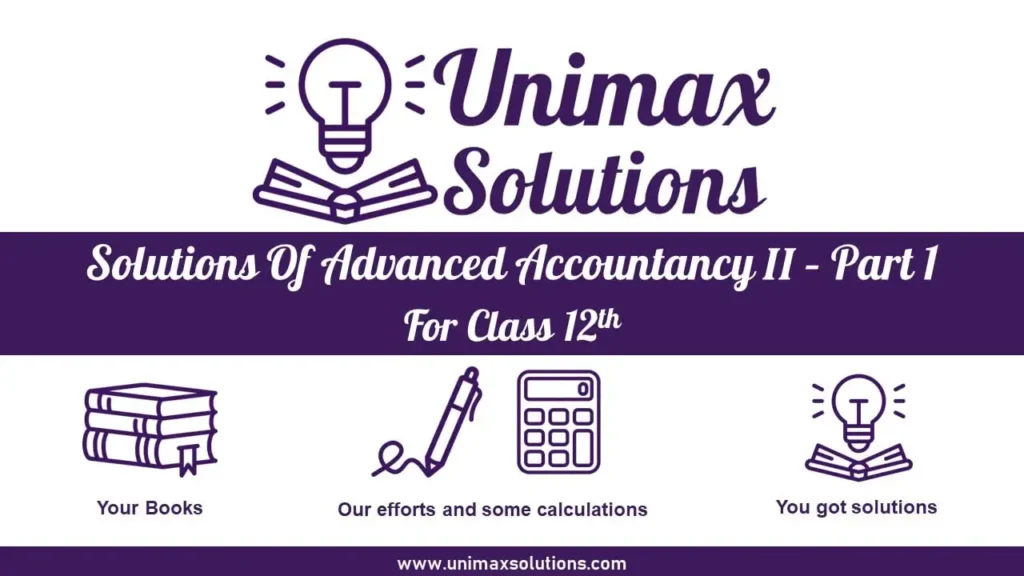
The Chapter-wise Solution of Advanced Accountancy II Part 1 Class 12 by Unimax is shown below:
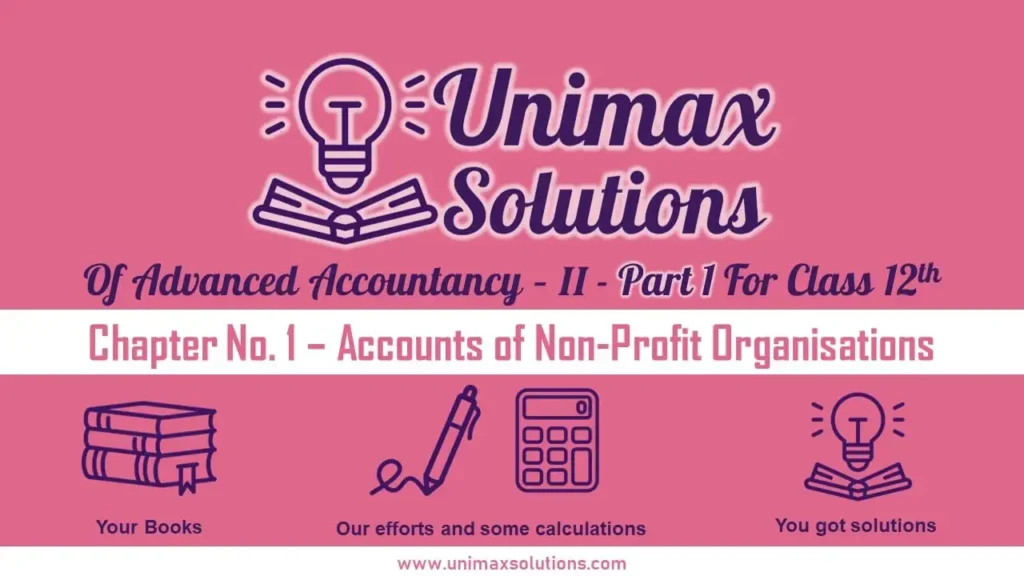
This chapter explores the accounting aspects of non-profit organizations, focusing on their unique characteristics and objectives. It begins by defining non-profit organizations and highlighting the key distinctions between these entities and profit-oriented businesses. The chapter then delves into the specific accounting principles and procedures applicable to non-profit organizations. Topics covered include receipt and payment accounts, income and expenditure accounts, the preparation of balance sheets, and the treatment of items such as subscriptions, donations, legacies, and endowments. Through the use of practical examples and illustrations, students gain a clear understanding of the accounting methods employed by non-profit organizations.
Chapter No. 2 – Partnership Accounts – I (Basic Concepts)
In this chapter, the fundamental concepts and terminology associated with partnerships are introduced to lay the groundwork for partnership accounting. It commences by defining what constitutes a partnership and outlining its distinguishing features compared to other business structures. The chapter covers various aspects including partnership deeds, partnership agreements, and the rights, duties, and responsibilities of partners. Additionally, it provides an overview of different partner types, such as active, sleeping, nominal, and partner by estoppel. Furthermore, the chapter discusses the methods employed for profit distribution among partners, such as fixed ratio, fluctuating ratio, and interest on capital. Practical examples and illustrations are incorporated to facilitate a comprehensive understanding of the foundational concepts.
This Chapter centers around the concept of goodwill in partnership accounting. It begins by elucidating the significance and meaning of goodwill within a partnership firm. The chapter covers topics such as the factors influencing goodwill value, methods of goodwill calculation (average profit method, super profit method, and capitalization method), and the treatment of goodwill in various scenarios, such as the admission, retirement, or death of a partner. Moreover, the chapter discusses the relevant accounting entries about the valuation and treatment of goodwill. To enhance comprehension, practical examples, and case studies are included to illustrate the computation and accounting treatment of goodwill in different contexts.
Chapter No. 4 – Partnership Accounts – III (Change in Profit Sharing Ratio among Existing Partners)
This Chapter concentrates on the accounting aspects related to a change in the profit-sharing ratio among existing partners. It begins by exploring the reasons for altering the profit-sharing ratio and the implications for partners. The chapter covers topics including the adjustment of accumulated profits and losses, revaluation of assets and liabilities, treatment of reserves, and the adjustment of capital accounts. Furthermore, the chapter explains the necessary accounting entries to record the change in the profit-sharing ratio and the resulting adjustments in partners’ capital accounts. Numerous numerical examples and practice questions are provided to enable students to grasp and apply the concepts effectively
This chapter focuses on the accounting treatment involved in admitting a new partner into an existing partnership. The chapter begins by highlighting the reasons and benefits of admitting a new partner and proceeds to cover topics such as methods of admitting a partner, including the gaining ratio and sacrificing ratio, and the determination of the new profit-sharing ratio. Additionally, the chapter discusses the treatment of goodwill, revaluation of assets and liabilities, adjustment of accumulated profits and losses, and the preparation of the new partner’s capital account. Practical examples and case studies are incorporated to enhance understanding of the admission of a new partner and its impact on the partnership’s financial accounts.
Chapter No. 6 – Partnership Accounts – V (Retirement and Death of A Partner)
This Chapter delves into the accounting treatment of the retirement and death of a partner in a partnership firm. The chapter begins by discussing the implications and reasons for a partner’s retirement or death within the partnership structure. It covers topics such as the calculation of the retiring or deceased partner’s share of goodwill, the adjustment of accumulated profits and losses, the revaluation of assets and liabilities, and the distribution of the partner’s capital. Furthermore, the chapter explains the necessary accounting entries to record the retirement or death of a partner and the subsequent adjustments in the remaining partners’ capital accounts. Practical examples and case studies are provided to illustrate the accounting treatment in various scenarios.
This Chapter focuses on the accounting aspects involved in the dissolution of a partnership firm. The chapter begins by explaining the meaning and reasons for the dissolution of a partnership. It covers topics such as the different modes of dissolution, including dissolution by agreement, dissolution with the occurrence of a specific event, and dissolution by court order. The chapter discusses the preparation of the realization account, the treatment of assets, liabilities, and reserves, and the settlement of partners’ capital and loan accounts. Additionally, it explains the necessary accounting entries to record the dissolution and the subsequent distribution of the firm’s assets and liabilities among the partners. Practical examples and case studies are included to enhance understanding of the accounting procedures involved in the dissolution of a partnership firm.
2. Solution of Advanced Accountancy II Part 2 Class 12 by Unimax:
The Chapter-wise Solution of Advanced Accountancy II Part 1 Class 12 by Unimax is shown below:
In this chapter students delve into the topic of Company Accounts, specifically focusing on Share Capital. This chapter introduces students to the concept of share capital and its significance in the functioning of a company. Students will learn about the different types of shares, such as equity shares and preference shares, and the various methods of issuing shares. They will gain insights into the accounting treatment of share capital, including the preparation of share capital accounts, the calculation of calls-in-advance and calls-in-arrears, and the treatment of forfeited shares. By studying comprehensive examples and exercises, this chapter aims to provide students with a thorough understanding of the accounting procedures and calculations related to company accounts and share capital.
Chapter No. 2 – Issue of Debentures:
Chapter 2 of Advanced Accountancy II Part 2 for Class 12 by Unimax focuses on the topic of the Issue of Debentures. This chapter explores the concept of debentures, which are long-term debt instruments issued by companies to raise funds. Students will learn about the various types of debentures, such as redeemable and irredeemable debentures, and the methods of issuing debentures, including at par, at a premium, and at a discount. They will gain insights into the accounting treatment of debentures, including the preparation of debenture redemption reserve, the calculation of interest on debentures, and the redemption of debentures. By studying comprehensive examples and exercises, this chapter aims to equip students with the knowledge and skills necessary to understand the accounting procedures and calculations related to the issue of debentures.
Chapter 3 of Advanced Accountancy II Part 2 for Class 12 by Unimax focuses on the topic of the Redemption of Debentures. This chapter delves into the process of redeeming debentures, which involves repaying the principal amount to the debenture holders. Students will learn about the different methods of redemption, such as redemption at par, premium, and discount, and the accounting treatment involved in each method. They will gain insights into the preparation of the Debenture Redemption Reserve (DRR) account, the calculation of interest on debentures, and the journal entries for the redemption of debentures. By studying comprehensive examples and exercises, this chapter aims to provide students with a thorough understanding of the accounting procedures and calculations related to the redemption of debentures.
Chapter No. 4 – Financial Statements of a Company (Balance Sheet Only):
This Chapter concentrates on the preparation of Financial Statements of a Company, specifically the Balance Sheet. This chapter introduces students to the concept of a balance sheet and its importance in presenting the financial position of a company. Students will learn about the different components of a balance sheet, including assets, liabilities, and shareholders’ equity. They will gain insights into the classification and valuation of assets and liabilities, the preparation of various schedules and notes to the accounts, and the presentation of a balance sheet in the prescribed format. By studying comprehensive examples and exercises, this chapter aims to equip students with the knowledge and skills necessary to understand the preparation and presentation of a company’s balance sheet.
Financial statement analysis plays a vital role in understanding the financial health and performance of a company. It involves the systematic examination of a company’s financial statements, such as the income statement, balance sheet, and cash flow statement, to assess its profitability, liquidity, solvency, and overall financial stability. By utilizing various tools and techniques, such as ratio analysis, trend analysis, and benchmarking, financial statement analysis provides valuable insights into a company’s strengths, weaknesses, and prospects. It helps investors, stakeholders, and management make informed decisions, identify potential risks, and devise strategies for growth and improvement. With its ability to uncover key financial indicators and trends, financial statement analysis serves as a crucial tool for evaluating the performance and financial viability of a company.
Chapter No. 6 – Tools/Methods of Financial Analysis:
Chapter 6 of Advanced Accountancy II Part 2 for Class 12 by Unimax focuses on the Tools/Methods of Financial Analysis. In this chapter, students explore various tools and techniques used to analyze the financial performance and position of a company. Students will learn about key financial ratios and their significance in evaluating a company’s liquidity, profitability, efficiency, and solvency. They will gain insights into ratio analysis, common-size statements, comparative statements, and trend analysis. By studying comprehensive examples and exercises, this chapter aims to provide students with the knowledge and skills necessary to interpret and analyze financial data using different tools and methods.
This Chapter dives deeper into the topic of Ratio Analysis. Building upon the previous chapter, this chapter focuses specifically on ratio analysis as a tool for evaluating a company’s financial performance. Students will learn about different categories of ratios, including liquidity ratios, profitability ratios, activity ratios, and solvency ratios. They will gain insights into the calculation, interpretation, and significance of various ratios, such as the current ratio, gross profit ratio, return on investment (ROI), and debt-equity ratio. By studying comprehensive examples and exercises, this chapter aims to equip students with the knowledge and skills necessary to perform ratio analysis and make informed decisions based on the results.
Chapter No. 8 – Cash Flow Statement:
Chapter 8 of Advanced Accountancy II Part 2 for Class 12 by Unimax focuses on the preparation and analysis of the Cash Flow Statement. This chapter introduces students to the concept and importance of a Cash Flow Statement, which provides information about the cash inflows and outflows of a company during a specific period. Students will learn about the classification of cash flows into operating, investing, and financing activities. They will gain insights into the preparation of a Cash Flow Statement using the direct and indirect methods, as well as the interpretation and analysis of the statement. By studying comprehensive examples and exercises, this chapter aims to provide students with a thorough understanding of the preparation, interpretation, and analysis of the Cash Flow Statement as a vital tool for assessing a company’s liquidity and cash management.
Advertisement

